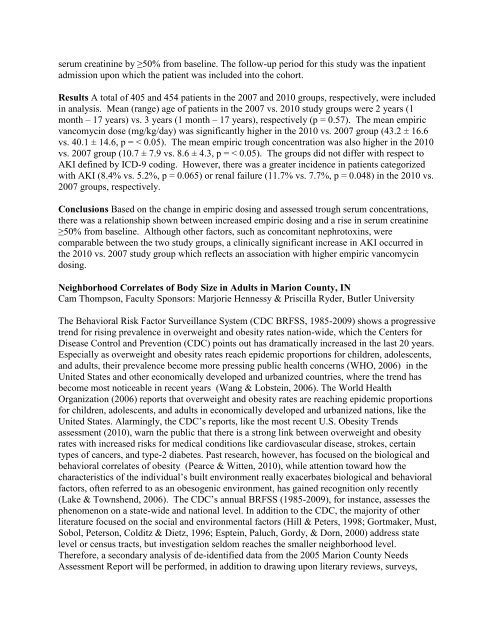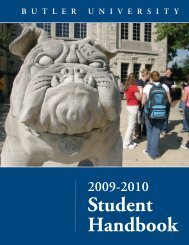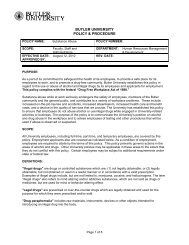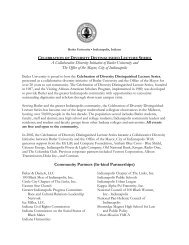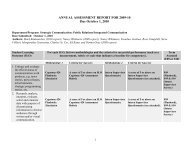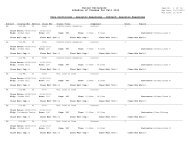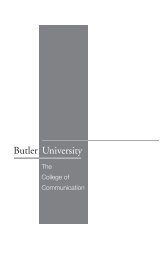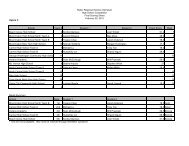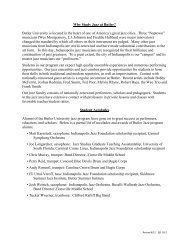Anthropology - Butler University
Anthropology - Butler University
Anthropology - Butler University
You also want an ePaper? Increase the reach of your titles
YUMPU automatically turns print PDFs into web optimized ePapers that Google loves.
serum creatinine by ≥50% from baseline. The follow-up period for this study was the inpatient<br />
admission upon which the patient was included into the cohort.<br />
Results A total of 405 and 454 patients in the 2007 and 2010 groups, respectively, were included<br />
in analysis. Mean (range) age of patients in the 2007 vs. 2010 study groups were 2 years (1<br />
month – 17 years) vs. 3 years (1 month – 17 years), respectively (p = 0.57). The mean empiric<br />
vancomycin dose (mg/kg/day) was significantly higher in the 2010 vs. 2007 group (43.2 ± 16.6<br />
vs. 40.1 ± 14.6, p = < 0.05). The mean empiric trough concentration was also higher in the 2010<br />
vs. 2007 group (10.7 ± 7.9 vs. 8.6 ± 4.3, p = < 0.05). The groups did not differ with respect to<br />
AKI defined by ICD-9 coding. However, there was a greater incidence in patients categorized<br />
with AKI (8.4% vs. 5.2%, p = 0.065) or renal failure (11.7% vs. 7.7%, p = 0.048) in the 2010 vs.<br />
2007 groups, respectively.<br />
Conclusions Based on the change in empiric dosing and assessed trough serum concentrations,<br />
there was a relationship shown between increased empiric dosing and a rise in serum creatinine<br />
≥50% from baseline. Although other factors, such as concomitant nephrotoxins, were<br />
comparable between the two study groups, a clinically significant increase in AKI occurred in<br />
the 2010 vs. 2007 study group which reflects an association with higher empiric vancomycin<br />
dosing.<br />
Neighborhood Correlates of Body Size in Adults in Marion County, IN<br />
Cam Thompson, Faculty Sponsors: Marjorie Hennessy & Priscilla Ryder, <strong>Butler</strong> <strong>University</strong><br />
The Behavioral Risk Factor Surveillance System (CDC BRFSS, 1985-2009) shows a progressive<br />
trend for rising prevalence in overweight and obesity rates nation-wide, which the Centers for<br />
Disease Control and Prevention (CDC) points out has dramatically increased in the last 20 years.<br />
Especially as overweight and obesity rates reach epidemic proportions for children, adolescents,<br />
and adults, their prevalence become more pressing public health concerns (WHO, 2006) in the<br />
United States and other economically developed and urbanized countries, where the trend has<br />
become most noticeable in recent years (Wang & Lobstein, 2006). The World Health<br />
Organization (2006) reports that overweight and obesity rates are reaching epidemic proportions<br />
for children, adolescents, and adults in economically developed and urbanized nations, like the<br />
United States. Alarmingly, the CDC’s reports, like the most recent U.S. Obesity Trends<br />
assessment (2010), warn the public that there is a strong link between overweight and obesity<br />
rates with increased risks for medical conditions like cardiovascular disease, strokes, certain<br />
types of cancers, and type-2 diabetes. Past research, however, has focused on the biological and<br />
behavioral correlates of obesity (Pearce & Witten, 2010), while attention toward how the<br />
characteristics of the individual’s built environment really exacerbates biological and behavioral<br />
factors, often referred to as an obesogenic environment, has gained recognition only recently<br />
(Lake & Townshend, 2006). The CDC’s annual BRFSS (1985-2009), for instance, assesses the<br />
phenomenon on a state-wide and national level. In addition to the CDC, the majority of other<br />
literature focused on the social and environmental factors (Hill & Peters, 1998; Gortmaker, Must,<br />
Sobol, Peterson, Colditz & Dietz, 1996; Esptein, Paluch, Gordy, & Dorn, 2000) address state<br />
level or census tracts, but investigation seldom reaches the smaller neighborhood level.<br />
Therefore, a secondary analysis of de-identified data from the 2005 Marion County Needs<br />
Assessment Report will be performed, in addition to drawing upon literary reviews, surveys,


